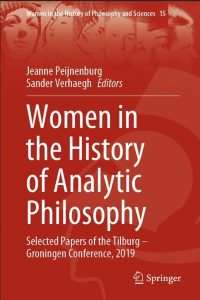The book Women in the History of Analytic Philosophy (2022), edited by Jeanne Peijnenburg and Sander Verhaegh, is part of the Springer series Women in the History of Philosophy and Sciences and presents a collection of papers from the workshop held in October 2019 in Tilburg, Netherlands, dedicated to highlighting the contributions of female philosophers to the development of early analytic philosophy.
About this book
This book contains a selection of papers from the workshop Women in the History of Analytic Philosophy held in October 2019 in Tilburg, the Netherlands. It is the first volume devoted to the role of women in early analytic philosophy. It discusses the ideas of ten female philosophers and covers a period of over a hundred years, beginning with the contribution to the Significs Movement by Victoria, Lady Welby in the second half of the nineteenth century, and ending with Ruth Barcan Marcus’s celebrated version of quantified modal logic after the Second World War. The book makes clear that women contributed substantially to the development of analytic philosophy in all areas of philosophy, from logic, epistemology, and philosophy of science, to ethics, metaphysics, and philosophy of language. It illustrates that although women’s voices were no different from men’s as regards their scope and versatility, they had a much harder time being heard. The book is aimed at historians of philosophy and scholars in gender studies.
Susan Stebbing’s Metaphysics and the Status of Common-Sense TruthsAbstract
Susan Stebbing, the UK’s first female professor of philosophy, was highly regarded by her contemporaries but remains largely neglected by historians of analytic philosophy. Very little has been written about Stebbing’s metaphysics, philosophy of science, and views on common-sense truths. Although recent commentators typically describe Stebbing, as Ayer had done, as “a disciple of Moore”, I will ascribe to Stebbing a distinctive view of her own in some respects allied to Moore, in some respects to Whitehead, in some respects wholly original. This becomes clear once we consider, as previous commentators have not done, the connections between Stebbing’s views on common sense, metaphysical analysis, philosophy of science, and the refutation of idealism. It is rarely noticed that Moore’s anti-idealist “Defence of Common Sense” does not end with a triumph over the idealist, but in aporia. Moore’s emphasis on the truth of common-sense claims turned out to leave room for forms of idealism which accept common-sense truths but analyse them in idealist terms. Such analyses were embarrassing to Moore because he considered them “paradoxical”. Stebbing, I argue, made a significant advance on Moore by distinguishing “same-level”, language-to-language, analyses, from metaphysical, directional analyses of the facts which account for the truth or falsity of expressions. Metaphysical analyses, Stebbing held, may well sound paradoxical and yet be correct, because they involve significant and possibly surprising assertions about reality, which ultimately settles truth or falsity. Stebbing applied her novel methodology of metaphysics to good effect in her philosophy of science. In Philosophy and the Physicists, Stebbing rebutted Eddington’s idealist line, which includes the assertion that every familiar object has a “shadow” object in the world of physics. She argued that the scientific truth “this table is mostly empty space and some subatomic particles” constitutes, despite its “paradoxical” appearance, an admissible directional analysis of “this table is solid”, so we need not posit both a solid table and its physical shadow. Thus Stebbing’s method might succeed where Moore’s failed, providing a new and viable route towards the refutation of idealism.
Abstract
Although the significs movement that Victoria, Lady Welby (1837–1912) inspired was dedicated to better understanding meaning, she has largely been forgotten by analytic philosophers of language. Significs was to educate “the great world of hearers and the growing world of readers” to better interpret science and philosophy, evincing a focus on the audience for intellectual activity that it remains vital for academics to consider. Her arguments that the metaphorical associations of terminology are part of their significance for others also pertain to contemporary programs of conceptual engineering which seek to craft and stipulate the meaning of terms. Welby would prefer, I contend, P. F. Strawson’s connective model of analysis, in which the aim is neither to replace nor reduce our concepts, but rather to carefully describe their interrelations. Connective analysis, she would argue, encourages us to keep others, rather than ourselves, firmly in view. I close by turning the lens afforded by Welby’s suggestions for educational reform upon the way we might best communicate philosophical ideas throughout society.
Interested? You can find the complete series here.
You cannot copy content of this page









